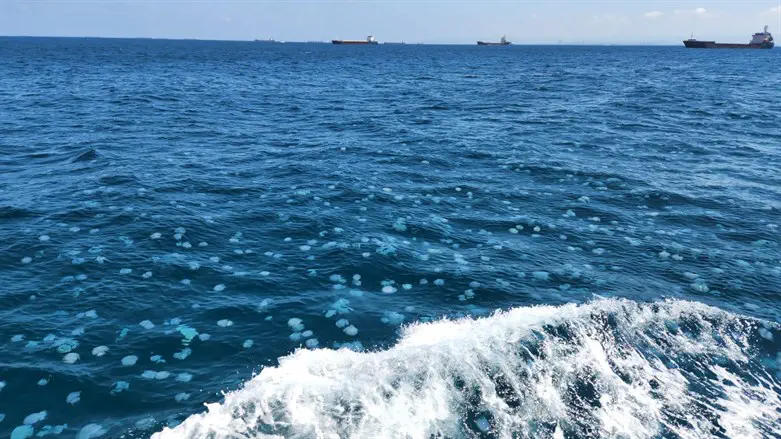
The unusually large swarms of jellyfish along Israel’s northern border currently can be problematic but are not an immediate cause of concern, Prof. Dror Angel of University of Haifa's Department of Maritime Civilizations explains.
According to Prof. Angel, while it is natural for Israel to experience jellyfish blooms every year, what is unusual with this particular swarm is its intensity. Although it's difficult to measure the size of a bloom, since quantifying a constantly moving mass that lives above and beneath the ocean’s surface is almost impossible, photos alone demonstrate that this year’s bloom is indeed unusually large.
A likely reason behind the intensity of this year’s bloom is climate change and the long, cold winter Israel experienced over the past year.
“The past winter has been very rainy and cold at times. This may have affected the intensity of the blooms and its life cycle,” Prof. Angel hypothesizes. “We know for sure if there’s heavy rain, then lots of nutrients get washed into the sea. So there's more algae, plankton and more food for the jellyfish to eat.”
While it’s natural to be concerned that this bloom may be the new normal, Prof. Angel points out that Israel has seen a large bloom of jellyfish like the one we’re currently experiencing every few years. In fact, the last large blooms occurred in 2015 and 2017. Even if there is another abnormally cold and long winter in 2023, that does not necessarily mean we can expect more jellyfish the following summer.
“Biology isn’t an exact science. There may be something that comes along in the ecosystem and eats the jellyfish, giving us a small bloom next year,” he says. “What's important to emphasize is that while jellyfish are a natural phenomenon, humans may be exacerbating matters. Pollution tends to equal more jellyfish.”
Right now, the jellyfish are huddled along Israel’s northern coast and have not yet reached the shore en masse. It is possible that a northern current will eventually push them into Syrian or Turkish waters, or even the open sea.
Yet, the presence of jellyfish along Israel’s northern coastline means much more than irritated beach goers.
On an ecological level, a growing jellyfish population may have a detrimental effect on the food web, as they compete with many different fish for the same food sources. Thus, a jellyfish bloom can cause other fish to starve.
Additionally, power plants are often inconvenienced at a great expense because blooms can clog the turbines they use in the sea. Fisheries and desalination plants are also susceptible to being negatively affected when jellyfish blooms dominate the waters and coastlines.
For now, researchers are still trying to understand the movement and behavior patterns of jellyfish, especially how blooms are formed. Prof. Angel suspects that their tendency to be grouped together may be a result of some sort of communication between them for defensive or reproductive purposes.
To further complicate matters, Israel is home to about 10 different kinds of jellyfish, so unraveling the behavior patterns of them all is an extensive undertaking for scientists.

